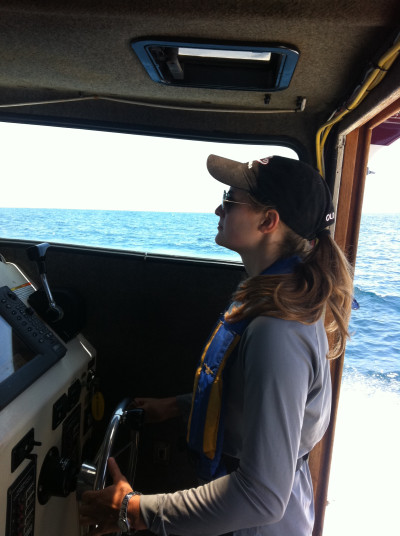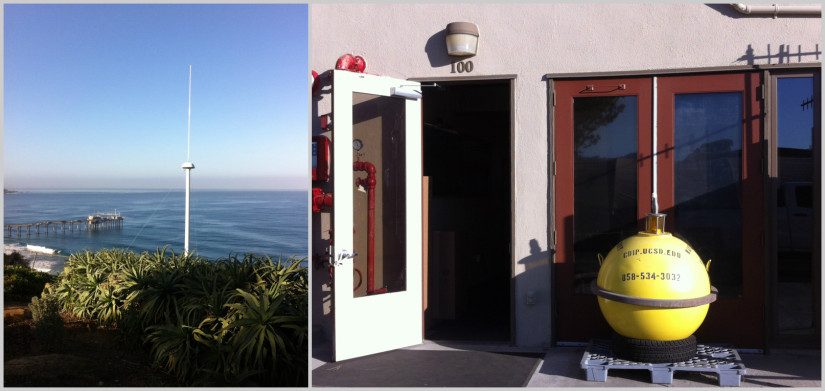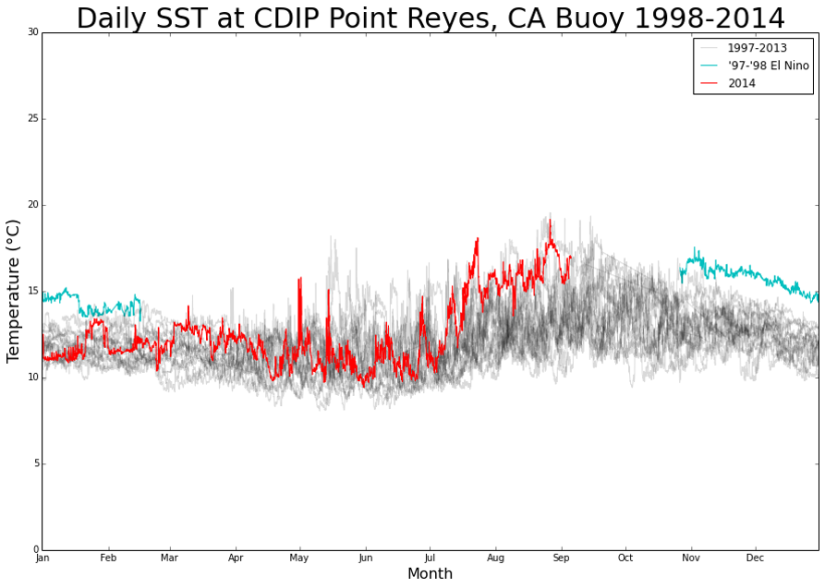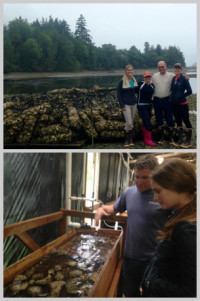
Twelve months later, I can rattle off the names of my host agencies in one confident breath (try saying ‘Ocean Observing System’ three times fast, with several geographic and governmental qualifiers thrown in, and you get the idea). Because my position is based at the Southern California Coastal Ocean Observing System (that’s SCCOOS) in beautiful La Jolla, CA, I have been able to observe many of the day-to-day workings of the oceanographic data collection that SCCOOS employs. SCCOOS is well-known for the array of real-time ocean observing platforms that it has created and maintains. My lunch break ocean views are framed by a Coastal Observing Research and Development Center (CORDC) high-frequency radar (HFR) station that measures real-time surface currents, and the door of my office is marked by a yellow Waverider buoy used by the Coastal Data Information Program (CDIP) to monitor wave conditions. Both the HFR surface currents and the CDIP wave and sea surface temperature datasets have formed core components of my product development. Best of all, when I have a question, I can simply walk next door to check in with the people who collect the data.
A large part of my fellowship involves working with data and agencies outside of Southern California. While the West Coast OOS Regional Associations (RAs) are all housed under the national Integrated Ocean Observing System (IOOS) network, and share data across geographic boundaries, each RA has its own focus within coastal oceanography and ocean health monitoring. My fellowship has helped me explore these nuances, giving me a better understanding of the variety of coastal environments and marine-related issues around the U.S.

This spring, I had the opportunity to visit another of my host OOSs, the Central and Northern California Ocean Observing System (CeNCOOS), along with several of their partner organizations. CeNCOOS is based at the edge of the world-renowned Monterey Bay and Monterey Submarine Canyon, giving it the ideal position to work with a host of academic collaborators, including the Monterey Bay Aquarium Research Institute (MBARI), UC Santa Cruz, the CSU Moss Landing Marine Lab, Stanford University’s Hopkins Marine Station and the Naval Research Laboratory. During my visit, I attended a Marine Debris Symposium hosted by the Monterey Bay National Marine Sanctuary (MBNMS), and presented a poster on my fellowship work connecting Ocean Observing System data to marine debris. The Symposium gave me the opportunity to learn about marine debris cleanup and reduction efforts around California, and connected me with people interested in using the data products I have created. Seeing potential applications for these products motivated me to solve several tricky coding problems to improve my products.

In August, I had a wonderful trip to Oregon and Washington to visit my third OOS host, the Northwest Association of Networked Ocean Observing Systems (NANOOS), and its stakeholders. In recent years, NANOOS has collaborated closely with shellfish farmers in the Pacific Northwest to help monitor, understand and highlight the detrimental effects of increasing ocean acidification on shellfish growth and survival. During my visit, I toured several shellfish farms to hear how they benefit from collaborations with NANOOS. One aspect of my fellowship has involved updating the West Coast Ocean Acidification Assets Inventory (a list of West Coast OA monitoring equipment and stations), which is being incorporated into the new IOOS Pacific Region OA Portal. Learning firsthand about the impacts of OA on larval growth and shell formation added value and context to the extensive lists of monitoring assets and data that I had been working with.

I also attended several WCGA meetings throughout the year, to help me understand West Coast ocean policy and how my fellowship could contribute meaningful data to West Coast ocean partnerships. I have had the chance to help plan this year’s West Coast Ocean Data Network Meeting, which focused on unveiling the West Coast Ocean Data Portal and associated datasets and connections developed this year, including the WCGA-OOS partnerships that I have helped work on during my fellowship.
My California Sea Grant Fellowship has been an incredible growth experience. Wrangling Pythons (coding scripts) and refining my knowledge of West Coast oceanography and ocean organization acronyms has helped me realize that integrated, policy-applicable oceanographic work is what I want to do in the future. I will miss working at the incredible Scripps Institution of Oceanography, but will be taking time to travel and pursue my land- and ocean-based interests, including horse polo, bird-watching, tall-boat sailing and SCUBA diving. I will be checking the CDIP wave forecasts religiously as I attempt to learn to surf, and will remain vigilant in my quest to pick up every scrap of beach trash and to educate fellow grocery-shoppers about the environmental benefits of reusable bags. I hope to dive back into the world of oceanography soon, via a Ph.D. program or related work. Maybe someday, I’ll find my way back to the Ocean Observing Systems.
Written by Laura Lilly
A version of this article first appeared on The West Coast Governors Alliance on Ocean Health blog in January 2015.
